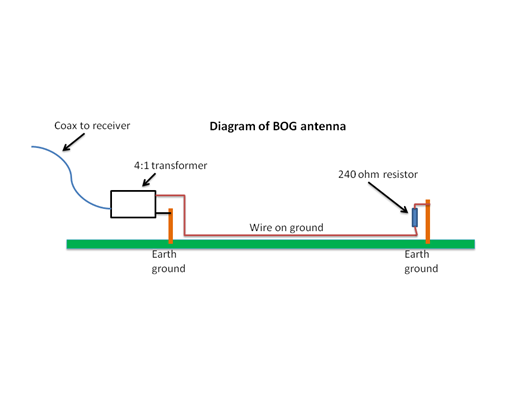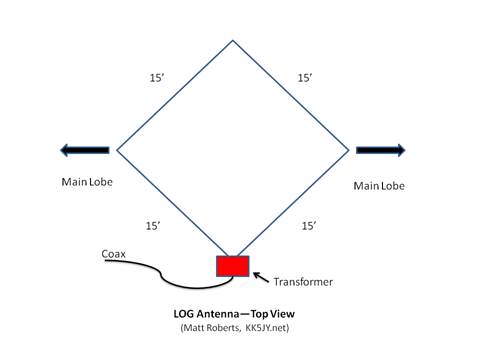Many hams I know who are serious 160 and 80 meter operators use Beverage antennas to optimize HF reception. These antennas often make the difference in pulling a weak signal out of the noise.
But conventional Beverage antennas are completely out of the question for many of us who live on small lots. They’re generally hundreds of feet long and need to be installed 5 to 10 feet above ground level. To work the low bands, we really need antennas like these when operating in noisy urban environments–the Catch 22 is we don’t have the room. But there are alternatives which will fit into smaller spaces.
BOG–Beverage on Ground
An adaptation of the conventional Beverage antenna, this configuration places the wire on or slightly in the ground. Antennas installed on the ground are not a new idea. Several sources suggest the very first Beverage antenna made by Dr. Harold H. Beverage himself was in fact a BOG.
Due to the effects of the earth, these wire receive antennas only need to be a straight run of around 160 to 200 feet long because the overall electrical length of the antenna is nearly twice as long as its physical length. Like the conventional Beverage, it’s terminated with a resistor–in this case 240 ohms. Both the resistor at the far end of the wire and the BOG transformer feed point unit are each connected to separate ground rods.
A 4:1 transformer matches the 50-ohm coax to the BOG. Homebrew transformers can be constructed with ferrites and several turns of wire. A ready-made version by KD9SV Products, BOG Beverage-On-Ground Antenna Transformer, is available from DX Engineering. The Unified Microsystems BevFlex-4X includes a flexible set of components for building a BOG and other varieties of receive antennas.
It’s strongly recommended that you install a common-mode choke in the feed line with a ground stake at a distance of about 33 feet from the antenna feed point.

Setup is simple and keeps you on the ground with no ladders or tower climbing involved. There has to be enough flat ground to accommodate the antenna. Jogs and bends can affect your antenna pattern, but it will still work. The wire needs to be insulated (size is not critical, but 14 to 16 AWG seems to work well).
To keep people and pets safe (and your antenna!), place the wire as close to the ground as possible. Anchor your wire with metal landscape staples about every 3 feet, which will hold the wires in place until lawn roots grow over them. Soon, the wire and staples disappear! Just remember to increase your lawnmower cutting height for a few weeks to let everything take hold.
You’re not getting a super signal grabber here. BOG antennas don’t produce any appreciable gain–figures are typically from -20 to -10 dBi. Instead, good weak signal reception happens by improving the signal-to-noise ratio (S/N) of the received signals. This is not by just having a higher gain antenna (more S in the S/N equation), but also by reducing noise (lower N in the S/N).
If needed, the receive signal can be boosted with a good RX preamplifier. Sometimes the one on your radio will be sufficient, or you can choose an outboard preamp such as the DXE RPA-2. Signal levels can also be improved by mounting the BOG an inch or two above ground level when it can be protected from being a tripping hazard.
A variant of the BOG is called the Snake antenna made from coax. It can be any coax you happen to have lying around like RG-58, RG-59, LMR 240, etc. At the tip, the center conductor must be connected to the braid. Connect a PL-259 plug at the shack end, but leave a gap of about an eighth of an inch in the braid. The braid should be isolated from the chassis of the ATU.
The coax can then be run anywhere. Just lay it on the ground–it does not have to be straight but can be placed in a series of serpentine S’s.
LOG Antenna
“My goodness! My gracious! It’s something brand new! A LOG for a BOG is something to do.” Aside from the corny Seuss-like rhyme, a LOG antenna is a BOG with some significant changes.
LOG stands for Loop on Ground, a version of the traditional loop antenna on terra firma. The loop of wire can vary in circumference from about 20 to 150 feet and can be a very space-efficient ground-mounted antenna for reception on the low bands. The shape should be as close to a diamond or square as possible.
The proximity of the wire to the ground makes this antenna very lossy. For reception, however, a lossy antenna is a good thing. Like the BOG, the LOG does a good job of improving the signal-to-noise ratio. Signals need only to break the noise level by a few dB to be received.
The antenna itself is not grounded, and it uses an isolation transformer at the feed point. This provides a near-short circuit at DC on both sides of the transformer, while DC-isolating the antenna from the cable. This isolation also helps to preserve the pattern of the antenna. The coaxial cable shield is grounded at the building entry point, providing some lightning and static protection.

Best results occur when the overall loop length is about 15% of a full wave for the lowest frequency. As shown in the diagram, a 60-foot total length works well for the 2-8 MHz range. It is usable to about 15 MHz, though sensitivity noticeably drops off above 25 MHz. At 100 feet coverage is extended into 160 meters and the upper portion of the AM broadcast band.
So What Do You Get for Your Efforts?
Initially it may sound like you’ve connected to a dummy load because there is no noise and signal levels will be down. But signal-to-noise ratio levels will more than make up for the perceived signal loss. A signal level of -100 dBm is a HOT signal when the noise level is down at -140 dBm. That leaves you 40 dB SNR, a clear signal.
The advantages of using the BOG or LOG are:
- Some directivity and a wider bandwidth than resonant antennas. The LOG tends to be somewhat non-directional.
- An antenna no one will notice, especially if you follow the installation tips mentioned earlier.
- The various types of Beverage antennas will become more useful during Solar Cycle 25 as increasing sunspot activity leads to even weaker signals on 160 and 80 meters.
- Even a short Beverage antenna is better than no Beverage! These versions are relatively easy to build and install in limited space.
- Better signal-to-noise levels in urban areas with RFI.
In case you were wondering, this isn’t a transmitting antenna. Locating the antenna at ground level makes it very lossy, rendering it useless for transmission. For reception, however, a lossy antenna can be a great asset, with the pattern and directivity very helpful at longer wavelengths.

